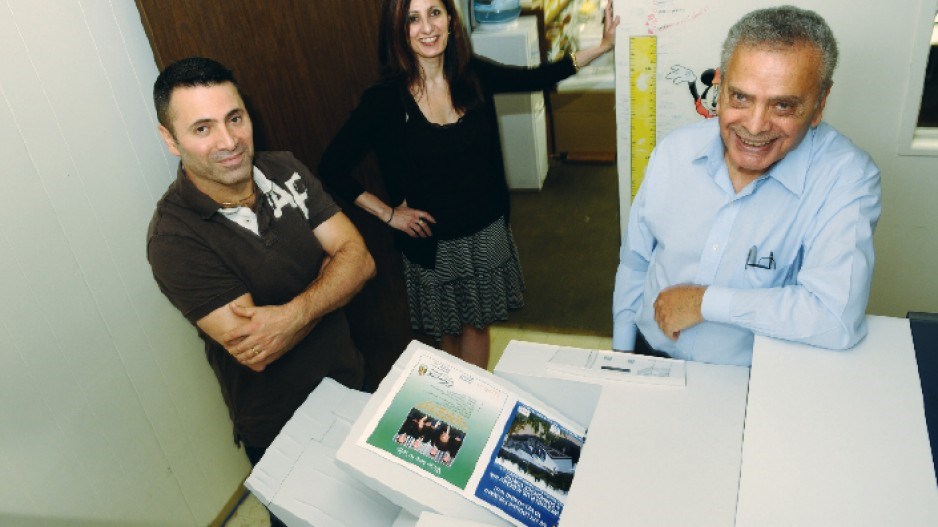Fifty-five years is a long time to be in business; even more so when your business is in the hyper-competitive printing industry. When new technologies disrupt old business models and erode profitability, only the smart survive.
John Fayad is one of them. Since he bought Grandview Printing in 1957, Fayad has survived a number of business changes, including acquisitions, partnerships and spinoffs. Since the beginning, Fayad’s family has been working with him: first his elder brother Joe, then his wife Gabrielle and daughter-in-law Monica, and now, his children Michael and Christina.
“The fun of it keeps me alive‚” Fayad said. “The fun of coming to work and being involved with customers who are my friends and children I love very much who I’m working with. [It’s] a unique way of living.”
Fayad worked out his succession plan a little over a decade ago. He and his wife sold 90% of the business to their son and daughter in equal shares. The couple retains a 10% ownership stake.
Fayad believes the transfer has worked well because of the distinct roles each family member plays within the business. Fayad oversees client relations; his son is the pressroom manager; his daughter is the office manager and graphic designer.
“They’re not in each other’s hair,” Fayad said. “Each of them [is in a] different department. One does not interfere with the other – so therefore they get along quite well.”
When it comes to management, Fayad takes the lead, but everyone has input.
“I’m still managing,” Fayad said. “Final decisions usually are mine, because the children want it this way. Nonetheless, they contribute a lot to it.”
“There are always some challenges,” Fayad admitted. “Nonetheless, in our case, it [has] worked perfectly. We’re the kind of family that we work together all week, and on weekends one of us will invite the others for a dinner on Sunday.”
Wendy Sage-Hayward, instructor at the Business Families Centre at UBC’s Sauder School of Business, applauds Fayad for addressing what may be the most important issue currently facing Canadian family businesses.
“Without a doubt, for [business] families in Canada … where we have this massive baby boom population, we’re facing a big issue with succession,” she said.
It’s an issue Sage-Hayward knows personally. In addition to her work at the centre, she is also part owner of Minnesota-based Tilney Farms, a sixth-generation family business founded in 1885. Her partners: 40 of her cousins.
Sage-Hayward believes family business succession problems often stem from the singular focus of the first generation.
“Their whole world is working in the business,” she said. “They’re so focused working in the business, they’re not working on the business.”
Another potential problem: trying to select a leader too soon. By jumping right to the most difficult succession question, families create unnecessary strife.
“Especially among siblings, there is a lot of comparison and competition that can happen, in particular between same-gendered children,” she said.
As a result, the process of succession planning is often ignored.
“It becomes an ‘indiscussible,’” Sage-Hayward said. “It becomes one of these things: ‘Well, we’ll just figure it out.’ You hope it will resolve itself somehow.”
Ian MacNaughton, president of Transition Point Coaching, agrees that it’s rarely the financial issues that cause the greatest succession planning challenges in a family business.
“The ‘soft’ issues – emotional family dynamics, managing differences, sibling rivalry, and so on – are truly the hardest in business family enterprise,” he said.
Like Sage-Hayward, MacNaughton is both a family business owner and educator. He inherited his family’s insurance business at the age of 20 and has built and sold a number of successful businesses since then.
Today, he is a licensed psychotherapist counselling family business owners and heirs on succession-related issues.
MacNaughton believes communication is the key to a successful business transfer.
“Can [family members] actually communicate with each other? Or are they off having side conversations? Can they handle a disagreement and still go to Sunday dinner together, and let it go?” MacNaughton asked.
Part of the challenge is keeping family issues and business issues distinct. “One of the biggest things that can destroy things is when family issues start to intrude on business decisions,” MacNaughton said.
While MacNaughton acknowledges the two can never truly be separated, he believes families need to establish boundaries between the two.
“If you’re discussing family issues, have a way to discuss those. And if some of the family concerns are recommendations for the business, have a protocol for that.” •




